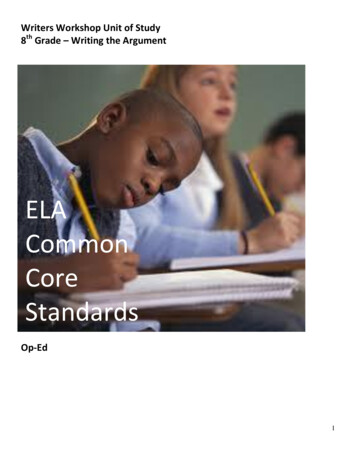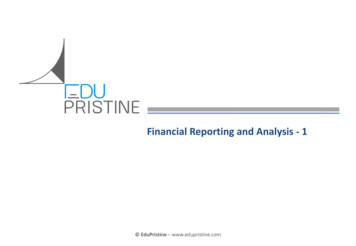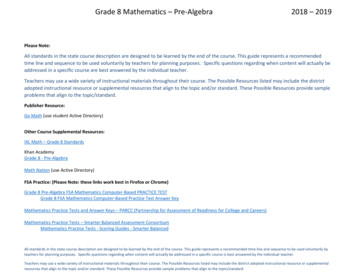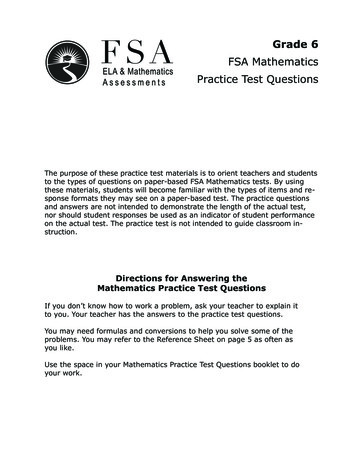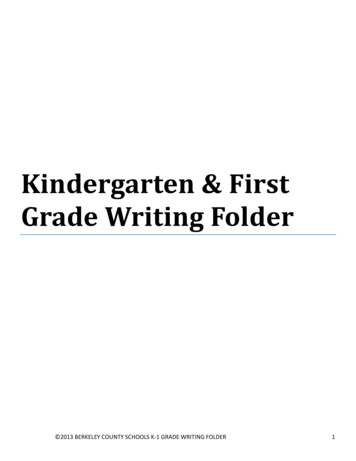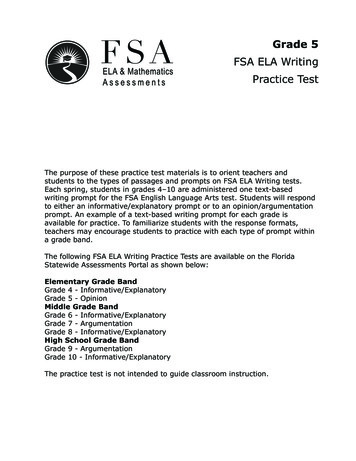
Transcription
Grade 5FSA ELA WritingPractice TestThe purpose of these practice test materials is to orient teachers andstudents to the types of passages and prompts on FSA ELA Writing tests.Each spring, students in grades 4–10 are administered one text-basedwriting prompt for the FSA English Language Arts test. Students will respondto either an informative/explanatory prompt or to an opinion/argumentationprompt. An example of a text-based writing prompt for each grade isavailable for practice. To familiarize students with the response formats,teachers may encourage students to practice with each type of prompt withina grade band.The following FSA ELA Writing Practice Tests are available on the FloridaStatewide Assessments Portal as shown below:Elementary Grade BandGrade 4 - Informative/ExplanatoryGrade 5 - OpinionMiddle Grade BandGrade 6 - Informative/ExplanatoryGrade 7 - ArgumentationGrade 8 - Informative/ExplanatoryHigh School Grade BandGrade 9 - ArgumentationGrade 10 - Informative/ExplanatoryThe practice test is not intended to guide classroom instruction.
To offer students a variety of texts on the FSA ELA Writing tests, authenticand copyrighted stories, poems, and articles appear as they were originallypublished, as requested by the publisher and/or author. While thesereal-world examples do not always adhere to strict style conventions and/orgrammar rules, inconsistencies among passages should not detract fromstudents’ ability to understand and answer questions about the texts.All trademarks and trade names found in this publication are the propertyof their respective owners and are not associated with the publishers of thispublication.Every effort has been made to trace the ownership of all copyrightedmaterial and to secure the necessary permissions to reprint selections.Some items are reproduced with permission from Cambium Assessment,Inc., as copyright holder or under license from third parties.Page 2
BLANK PAGEPage 3
FSA ELA Writing Practice TestRead the “Should Elementary School Students Switch Classes?”passage set.Should Elementary School Students Switch Classes?Source 1: Difficult Decisions for Schoolsby Lillian James1If your school is like most elementary schools, you stay with thesame teacher to learn subjects like math, reading, science, and socialstudies. You might switch classes for gym, music, or art. But when youget to middle school, you’ll likely have a different teacher for eachsubject. Some people wonder whether students should switch classesearlier than in middle school.2Schools all over the country are changing to this model to see whetherit improves student learning. Some schools are happy with the newsystem. Kathleen Marchetti is a fifth-grade teacher at a school inSalem, Massachusetts. She feels that switching classes allows her thetime to be more creative than she could when she taught all subjects.Marchetti also points out there are some difficult parts of switchingclasses—for example, having more students than she did before.3Other schools have had less success with switching classes. Theteachers don’t have enough extra time to plan together. They prefera single classroom where they can plan at their own pace.4Brian Roberts is the assistant principal at Liberty Elementary School inAzle, Texas. He notes that parents have had mixed reactions. Someparents love how their children are learning more about each subjectfrom teachers who are experts in that subject. Other parents find ithard to communicate with teachers. They feel it is easier to talk to oneteacher who teaches their child all day, rather than try to talk withmany teachers.5While switching classes at a young age can work for some kids,parents, and teachers, others will continue to find it hard. Schools willhave to weigh the benefits and the drawbacks of each model to figureout what is best for their students.“Difficult Decisions for Schools” by Lillian James. Written for educational purposes.Page 4Go On
FSA ELA Writing Practice TestSource 2: Deeper Learning ThroughSpecializationby Leon Samuels6Nearly every high school in the country has different departmentsfor each subject. The math teacher has a math background. The scienceteacher has a deep understanding of earth science or physics. Theseteachers get to teach what they know and take pride in knowing it well.7If this is good for high school students, it would help youngerstudents as well. Younger children should move between differentclasses during the day so that they can learn more from teachers whoare masters of their subject matter.8Some schools have already started switching classes in elementaryschool. Education consultant Steve Peha has seen the percent of hisschools that switch classes increase from 5% to 20% in the past15 years.9When a teacher teaches the same lesson throughout the day, he orshe can ensure that students fully understand the material. The lessonmay be of higher quality since the teacher only has to prepare oneoutstanding lesson to teach several times each day.10Teachers can take classes to deepen their knowledge of theirsubjects. Susana Cordova, the chief academic officer of elementaryschools in Denver, Colorado, elementary schools, has seen increasedinterest in teacher training in single subject areas. According toCordova, teachers feel that they learn more quickly when they onlyteach one subject area.11Ian Yale is the principal at Columbia Elementary School in Burbank,Washington. He says that even though he pays more for teachertraining, he saves on school materials. Yale points out that he needed90 books when each teacher taught math. But when one teacherteaches math to 30 students at a time, he only needs 30 books thatcan be used over and over again.12Students, teachers, and school leaders can all benefit fromswitching classes. With careful planning and good communication,students learn the most when they switch classes, even in elementaryschool.“Deeper Learning Through Specialization” by Leon Samuels. Written for educational purposes.Page 5Go On
FSA ELA Writing Practice TestSource 3: One Student, One Teacherby Lucille Ruby13Young children need guidance, support, and stability. According toDonna Snyder, a professional development expert, this is provided bychildren’s classroom teachers. By staying in one classroom with oneteacher for the whole day, the youngest students can bond with theirteachers. This connection with their teacher gives the young studentconfidence and creates a safe environment for learning.14Some schools are starting to consider having young students switchclasses during the day. Seeing a different teacher for each subject maymean less work for the teacher. The teacher only teaches one lessonover and over each day, rather than planning a full day of lessons.Students, however, do not get to bond with teachers when they areonly with each teacher for a short time each day.15A lot of time is lost when a child changes classes during the day aswell. Students lose teaching time when they switch classrooms.Principal Kim Doepker of Blue Ridge Elementary in Walla Walla,Washington, notes that many young students have a hard time withtransitions. Spending more time each day moving from room to roomwill make it harder for these students to learn.16Teachers also lose some freedom in their schedules. Teachers inmulti-subject classrooms can extend a lesson as needed when they donot need to stick to a strict schedule. The teacher can also make moreconnections across subject areas when teaching. For example, thestudents may be learning about ancient Greece during social studies.They could then read stories about ancient Greece during reading, orstudy ancient Greek water systems during science.17Students need to switch classes in high school. These studentsneed to learn from experts and focus on deeper learning in eachsubject as they prepare for college and careers. Young students needmore of a bond with their teachers to develop a love of learning. Whileswitching classes works well for older students, it does not meet theneeds of the youngest learners.“One Student, One Teacher” by Lucille Ruby. Written for educational purposes.1018Page 6Go On
FSA ELA Writing Practice TestWriting PromptWrite an article for the school newspaper in which you give youropinion about whether students in your school should switch classes fordifferent subjects. Use information from the passages in your article.Manage your time carefully so that you can read the passages; plan your response; write your response; and revise and edit your response.Be sure to include an introduction; support for your opinion using information from thepassages; and a conclusion that is related to your opinion.Your response should be in the form of a multiparagraph essay. Writeyour response in the space provided.15050Page 7Go On
Page 8Go On
Page 9Go On
Page 10
BLANK PAGEPage 11
Office of AssessmentFlorida Department of Education, Tallahassee, FloridaCopyright 2020 State of Florida, Department of State
prompt. An example of a text-based writing prompt for each grade is available for practice. To familiarize students with the response formats, teachers may encourage students to practice with each type of prompt within a grade band. The following FSA ELA Writing Practice Tests are available
